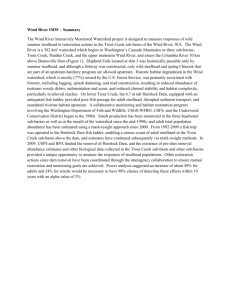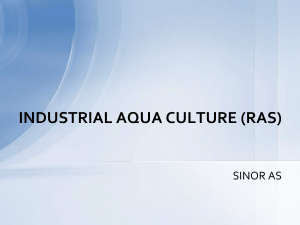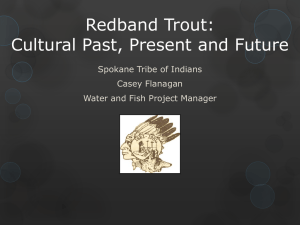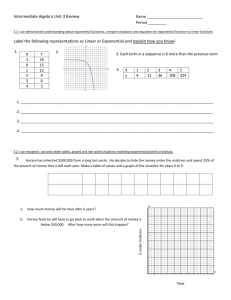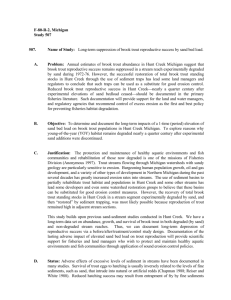Boardman River Assessment Reply – Dave Leonhard
advertisement
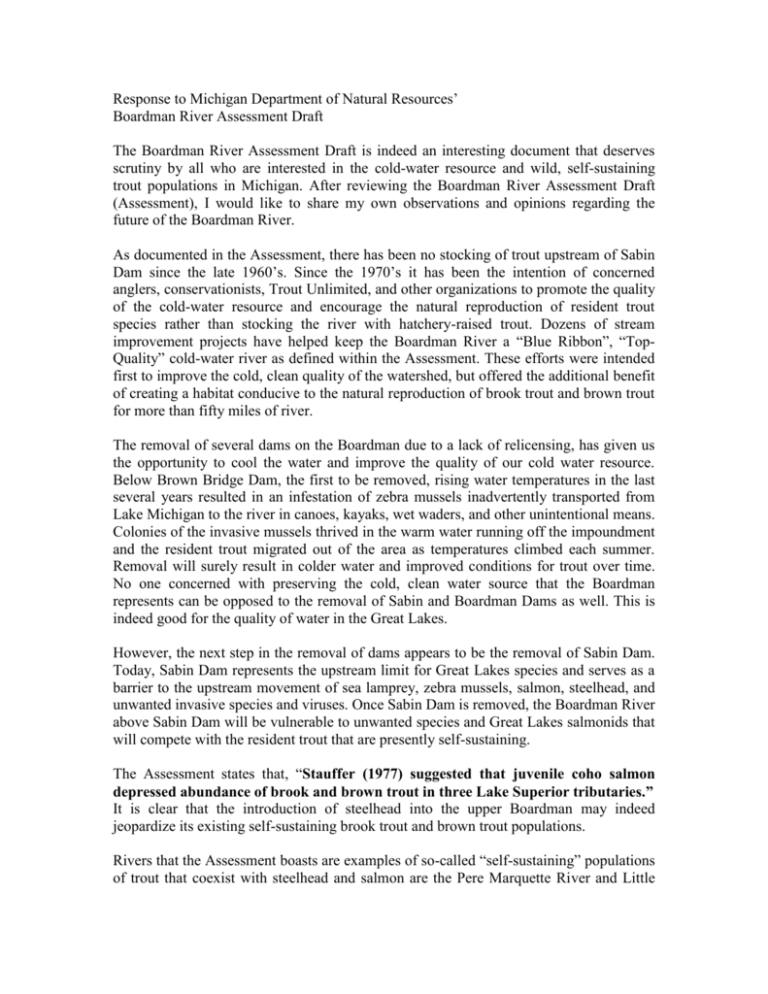
Response to Michigan Department of Natural Resources’ Boardman River Assessment Draft The Boardman River Assessment Draft is indeed an interesting document that deserves scrutiny by all who are interested in the cold-water resource and wild, self-sustaining trout populations in Michigan. After reviewing the Boardman River Assessment Draft (Assessment), I would like to share my own observations and opinions regarding the future of the Boardman River. As documented in the Assessment, there has been no stocking of trout upstream of Sabin Dam since the late 1960’s. Since the 1970’s it has been the intention of concerned anglers, conservationists, Trout Unlimited, and other organizations to promote the quality of the cold-water resource and encourage the natural reproduction of resident trout species rather than stocking the river with hatchery-raised trout. Dozens of stream improvement projects have helped keep the Boardman River a “Blue Ribbon”, “TopQuality” cold-water river as defined within the Assessment. These efforts were intended first to improve the cold, clean quality of the watershed, but offered the additional benefit of creating a habitat conducive to the natural reproduction of brook trout and brown trout for more than fifty miles of river. The removal of several dams on the Boardman due to a lack of relicensing, has given us the opportunity to cool the water and improve the quality of our cold water resource. Below Brown Bridge Dam, the first to be removed, rising water temperatures in the last several years resulted in an infestation of zebra mussels inadvertently transported from Lake Michigan to the river in canoes, kayaks, wet waders, and other unintentional means. Colonies of the invasive mussels thrived in the warm water running off the impoundment and the resident trout migrated out of the area as temperatures climbed each summer. Removal will surely result in colder water and improved conditions for trout over time. No one concerned with preserving the cold, clean water source that the Boardman represents can be opposed to the removal of Sabin and Boardman Dams as well. This is indeed good for the quality of water in the Great Lakes. However, the next step in the removal of dams appears to be the removal of Sabin Dam. Today, Sabin Dam represents the upstream limit for Great Lakes species and serves as a barrier to the upstream movement of sea lamprey, zebra mussels, salmon, steelhead, and unwanted invasive species and viruses. Once Sabin Dam is removed, the Boardman River above Sabin Dam will be vulnerable to unwanted species and Great Lakes salmonids that will compete with the resident trout that are presently self-sustaining. The Assessment states that, “Stauffer (1977) suggested that juvenile coho salmon depressed abundance of brook and brown trout in three Lake Superior tributaries.” It is clear that the introduction of steelhead into the upper Boardman may indeed jeopardize its existing self-sustaining brook trout and brown trout populations. Rivers that the Assessment boasts are examples of so-called “self-sustaining” populations of trout that coexist with steelhead and salmon are the Pere Marquette River and Little Manistee River. However, the Pere Marquette River has been heavily stocked with hatchery-raised fish over the last 30 years. Since 2000, nearly a quarter of a million brown trout have been stocked in the Pere Marquette alone. Self-sustaining numbers of brown trout declined, again, in direct proportion to the increasing numbers of steelhead and salmon in the river and necessitated the constant replenishment of brown trout. Sea lamprey infestation in the Pere Marquette has also plagued the DNR for two decades. While no brown trout are stocked directly into the Little Manistee River, millions of brown trout and steelhead have been stocked into the Manistee River since 2000. Those fish run into Lake Michigan. Certainly many have found their way into the Little Manistee to replenish the depleted numbers of brown trout and rainbows that are affected by the millions of salmon stocked into the Little Manistee over the same period. By contrast, no brown trout have been stocked into the Boardman River since the late 1960’s and yet we still have excellent brown trout fishing annually. Why would anyone want to jeopardize that truly self-sustaining river by introducing new species? Why would anyone want to risk the invasion of harmful Great Lakes species? There are so few protected self-sustaining rivers left. So many have worked so hard to create this wild trout fishery that it is senseless to endanger it. There is no definitive data to prove that the brook trout population will not be jeopardized with the introduction of Great Lakes salmonids, nor are there any reasonable assurances that additional unwanted invasive species will not find their way into the system with any new species. Trout populations in Lake Michigan rivers stocked with salmon and/or steelhead have declined precipitously over the last decade. Rivers such as the Jordan, Pere Marquette, Manistee, and other smaller streams suffer sea lamprey infestations in addition to declining resident trout populations. Most learned fisheries biologists are hard pressed to offer assurances that introduction of steelhead wouldn’t jeopardize the resident brook trout populations. Once the Boardman River is infested with lamprey, stocked with steelhead, and suffering declining wild trout populations, the only solution will be annual stocking of hatcheryraised trout. That would represent a step back fifty years to a time when the goal was to improve trout fishing by dumping more hatchery-raised trout into the rivers rather than spending half as much money to improve the habitat so that wild trout could reproduce naturally. Today, we already have wild, self-sustaining brook trout and brown trout populations in the Boardman. It makes no sense to jeopardize it to improve the populations of Lake Michigan steelhead. Virtually every river, stream, and creek that empties into the Great Lakes has runs of steelhead and salmon. The DNR claims that thousands of wild, naturally reproduced salmon and steelhead fill the rivers each year. For six decades we have been dumping millions and millions of steelhead and salmon into the Great Lakes and harvesting only small numbers. Yet, the DNR still cannot say that salmon or steelhead will ever become self-sustaining. Lastly, the Draft Assessment suggests that the stocking of steelhead in the Boardman above Sabin Dam will be an economic boost to the area. Wild brook trout and brown trout have made Boardman River frontage some of the most valuable real estate in the State. It is clean, cold water and healthy wild trout populations that make the Boardman River real estate valuable. Crowds of steelhead and salmon anglers lining the stream banks for three weeks in the spring and three weeks in the fall do not define economic stimulus. This is demonstrated on the Pere Marquette each season. If the goal is economic gain through the introduction of steelhead into the Boardman River, then there is no reason to jeopardize the brook trout and brown trout populations. Period. Sacrificing the wild ecosystem in the Boardman to replenish hatchery-raised fish for anglers to catch in Grand Traverse Bay is a poor trade-off. The Bear River, Jordan River, Elk River, Yuba Creek, Acme Creek, Mitchell Creek, Kids Creek, Crystal River, Shelde Creek, Betsie River, Platte River, Manistee River, Pere Marquette River, and dozens more Lake Michigan watersheds already support steelhead, salmon and other Great Lakes species and allow the upstream movement of both desirable and harmful ones. There is no shortage of watersheds for Great Lakes species to travel upstream. However, there are only a few watersheds that are protected from Great Lakes invasive species and viruses. Introducing new species into the Boardman River’s perfectly healthy ecosystem would be a mistake and would jeopardize its brook trout and brown trout populations. The Draft Assessment fails to address one very important area. It fails to offer a means of protecting the existing, healthy, self-sustaining cold-water ecosystem upstream of Union Street and Sabin Dams. There is no valid reason to allow Great Lakes species of any kind to pass upstream of Union Street Dam. Union Street Dam will not be removed because of its importance as a flood control dam and thus could serve as a natural upstream limit for fish passage and a protection from invasion of dangerous and harmful species. This can be accomplished by merely closing the fish ladder. The result will be a protected wild brook trout and brown trout population that has been self-sustaining for fifty years and the prevention of any upstream invasion of damaging invasive species. Such rivers are rare, even endangered. I respectfully submit that the Boardman River Assessment Draft does not adequately address the harmful effects of any plan that would introduce steelhead, or any other species, into the river upstream of Union Street and Sabin Dams. Allowing steelhead, salmon, and other species upstream of Union Street and Sabin Dams would endanger the existing brook and brown trout populations upstream and should be prevented. Respectfully, Dave Leonhard 223 E. Front Street Traverse City, Michigan 49684

